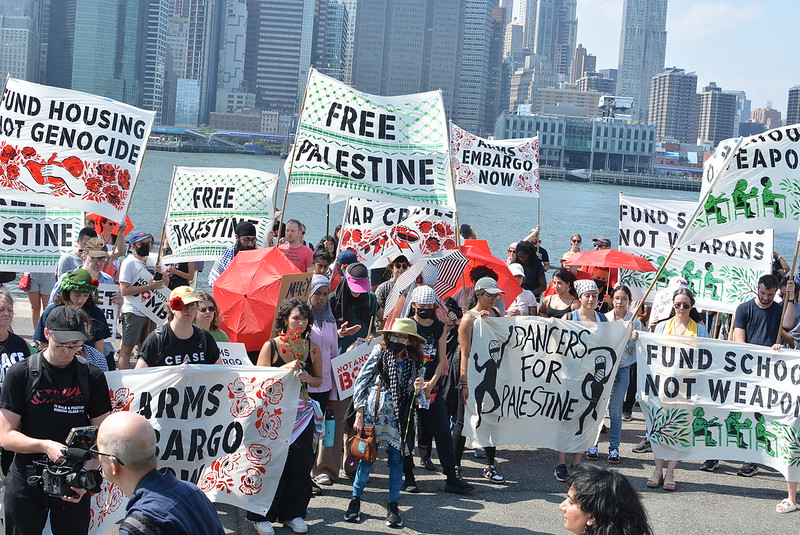
Not Another Bomb Protest, NY, Aug 2024. Photo by Nadav Spiegelman.
[ID: ID: A photo from a Not Another Bomb protest held in NY in August 2024. A crowd of about 40 people wearing keffiyehs, gathered are holding banners that reads; FREE PALESTINE, ARMS EMBARGO NOW, FUND SCHOOLS NOT WEAPONS, FUND HOUSING NOT GENOCIDE. The Dancers for Palestine banner is seen in the front row.]
As organizers with Dancers for Palestine, we’ve spent the last year urging our field to embrace the power of art and culture to advance the cause of freedom, dignity, and self-determination for Palestine. We support a variety of tactics, including direct action, creative resistance, legislative advocacy, organized labor, and Boycott, Divestment, and Sanctions (BDS). Through our relationships with experienced Palestinian organizers, we have come to understand the critical importance of BDS and its cultural component, the Palestinian Campaign for the Academic and Cultural Boycott of Israel (PACBI). We therefore must address the complicity of Israel’s most internationally dominant dance institutions, Batsheva Dance Company and the closely affiliated Gaga Movement, especially in light of Batsheva’s upcoming world tour.
Initiated in 2005 by a broad coalition of Palestinian civil society groups and modeled after anti-Apartheid boycotts in South Africa, BDS has increasingly been embraced by human rights advocates worldwide, including a growing number of Israelis.[1] Unfortunately, despite its liberal reputation, Batsheva has repeatedly refused to disavow its role as “cultural ambassador” for the Israeli state and commit to Palestinian liberation.[2]
We recognize that members of the dance field often feel conflicted about boycotting dance organizations. We hope that the following analysis can help establish that engaging with Batsheva and Gaga—through buying tickets, attending classes, or auditioning—has political implications.
State Funding and Brand Israel
While Batsheva is most widely known today for the choreographic work of Ohad Naharin (Artistic Director from 1990-2018 and current House Choreographer), Batsheva’s relationship with cultural imperialism originated much earlier. The company formed 16 years after Israel’s founding and was originally directed by American modern dance icon Martha Graham, whose international presence was supported by the US State Department. From the very beginning, Israel and its proponents viewed dance as a necessary component in establishing their cultural supremacy over Palestine,[3] much like the US’s vision of modern dance as a weapon in their worldwide campaign against communism.[4]
Unsurprisingly, Batsheva has become a useful tool in Israel’s 21st-century Brand Israel strategy, launched in 2005 to revitalize the nation’s image, especially with Americans. The campaign explicitly and publicly aims to move Israel’s role in the international public imagination from violence and conflict towards art, culture, youth, and modernity, both through direct government funding and by incentivizing private companies.[5]
The campaign invests heavily in arts and culture. Israel has long offered celebrities luxurious gifts and trips to win their public approval.[6] State-funded, international tours like Batsheva’s are also a part of this strategy, and state funding for internationally-facing art contractually requires artists to represent the state and its policies positively.[7] Notably, The Israeli Ministry of Foreign Affairs describes Batsheva as “the best known global ambassador of Israeli culture.”[8]
This “artwashing” relies upon international audiences, particularly Americans, believing that a society that creates great art cannot also create immense violence—or at least that the former outweighs the latter. It also disturbingly implies that Palestinians and others in the region are less worthy of life and security because they don’t produce the same “great art” that Israel does. (Of course, this premise relies on ignorance of Arab and Middle Eastern art legacies.)
Gestures of “Resistance”
Batsheva has been known to offer lukewarm opposition to Israeli leadership, satisfying an international dance sphere that is liberal-leaning but not politically critical. Within an Israeli society that is threatened by any mention of Palestine’s existence, vague references to Palestine in Batsheva dances[9] are often interpreted as sympathy. A September 2024 Instagram post, after nearly a year of genocide in Gaza, read “STOP THE WAR NOW. NO MORE BLOODSHED! We support hope, life, dignity and freedom for all.”
This limited opposition, to describe it generously, is enabled by the state because it ultimately serves to promote the image of Israel as a diverse liberal democracy. Political homogeneity and the absence of debate create the impression of authoritarianism among international audiences. However, the visible presence of opposition, carefully controlled by the state to remain relatively toothless, creates the illusion of political freedom. Naharin explicitly endorses this vision, declaring Israel has robust protections of expression[10] and that there is “no such thing as censorship in Israel,”[11] (even as he is threatened with censorship himself, as discussed below). But such statements overlook numerous well-documented restrictions of expression that disproportionately target Palestinian citizens of Israel.[12]
Consider the substance of Batsheva’s “resistance” highlighted in the documentary “Mr. Gaga.” Participating in the 50 year celebration of Israel’s founding, Naharin refused to change the costuming of his piece to appease the sensibilities of religious conservatives, even after the government’s warning and fears of losing funding. Yet the very premise of this event—commemorating nation-building through the ethnic cleansing of Palestinians during the Nakba—was never addressed.
Most recently, Culture Minister Miki Zohar has made attempts to halt Batsheva’s government funding for having a Palestinian flag on stage in a dance featuring dozens of other flags. Headlines about this drama fuel impressions of Batsheva as a source of artistic resistance. In reality, the piece has no discernable message of solidarity. Batsheva’s official communication following the Minister’s threats emphasized that the flag appeared “in a broad artistic context,” dispelling any suspicions of alignment with the Palestinian cause.11
This instance demonstrates the tight ideological restriction that comes with a “cultural ambassador” status. If an incidental reference to Palestine is off-limits, the hope that government-contracted artists and institutions could be a serious source of internal resistance is clearly misguided.
Gaga
While Batsheva tours have long been recognized as a BDS target for its government ties and cultural ambassador status, there has been less attention placed on Gaga Movement Ltd., the for-profit company dedicated to Ohad Naharin’s “movement language” Gaga.
Under BDS guidelines, Israeli companies can be considered boycottable if they do not publicly recognize the rights of the Palestinian people as enshrined in international law, including the end to occupation, the end to Apartheid discrimination, and the right of return for Palestinian refugees. Further, to be non-boycottable, they must end all complicity in whitewashing or justifying Israel’s violations of international law and Palestinian human rights. Because of Gaga Movement’s close affiliation with Batsheva, it can be considered a co-creator of Batsheva’s international brand and a member of the same artwashing project.
The seductive appeal of Gaga’s aesthetics on the international contemporary dance world in the last 15 years cannot be overstated. Franchised Gaga classes for dancers and non-dancers are now offered in dance studios and universities in over 20 countries, as well as online. Various workshops, intensives, and luxury dance retreats are offered in Israel and internationally.
Especially for those trained in more rigid techniques, the sensation-based classes can feel like a taste of freedom, seeding fantasies of Israel as a progressive art hub. As the elastic movement quality and improvisational skills associated with Gaga have become an expectation for professional dancers and Batsheva a common “dream company,” Tel Aviv has become an idyllic dance intensive destination, with dancer-tourists disregarding the guidelines of the BDS Call for Ethical Tourism/Pilgrimage.[13] For young dancers chasing their dreams, the formal separation of Batsheva and Gaga means little to nothing.
Many in the dance field are instinctively against boycotting any movement form. But the BDS boycott only targets official Gaga classes—which are financially connected to Gaga Movement Ltd.—not any aesthetic principles dancers might associate with the form. BDS addresses material ties, leaving artists to make more personalized choices about how to engage with movement traditions with problematic histories.
Ohad Naharin
Batsheva and Gaga are boycottable based on institutional complicity alone, regardless of the personal politics of any affiliated artist. However, because the public persona of Ohad Naharin is nearly synonymous with the Batsheva/Gaga “brand,” and because his vaguely progressive image has caused confusion about institutional complicity, his public politics warrant their own response.
Naharin is critical of Netanyahu and the Israeli right wing.[14] Yet this does not make him an ally to Palestinian liberation. Naharin has expressed sympathy for Palestinian suffering but undermines Palestinian political agency when he repeatedly misrepresents the BDS movement. Naharin characterizes BDS protesters as misguided foreigners, detached from Palestine and reality, recently declaring that “when BDS people demonstrate, it doesn’t help the Palestinians, unfortunately, but it does add drama.”14 He neglects to mention that BDS is Palestinian-led, based on the historical precedent of success in South Africa, and shaped by twenty years of strategic refinement.
One can understand why many American artists, working within their own problematic government and funding systems, sympathize with a choreographer who prioritizes funding over political conviction. But those who more easily relate to one the most powerful choreographers in the world above the many Palestinian arts groups—working in much more challenging circumstances and still rejecting funding with political conditions[15]—should reconsider the limits of their empathy.
What to do
Dancers and dance audiences of conscience should:
- Boycott Batsheva performances and auditions as well as Gaga classes and workshops.
- Urge your local institutions to cut ties with Batsheva, Gaga, and other complicit institutions.
- Contact Dancers for Palestine ([email protected]) for help drafting outreach language.
- Protest performances near you on Batsheva’s upcoming tour.
- Follow us for updates on protests (Instagram: @dancers_for_palestine)
- If you’re planning a protest, contact us to amplify to our followers and to provide you with materials and messaging suggestions.
- Find alternative dance forms. We encourage you to seek other improvisational, kinetic, and somatic practices that can provide a similar experience without supporting a propaganda arm of a genocidal government.
[1] Palestinians, Jews, citizens of Israel, join the Palestinian call for a BDS campaign against Israel
[2] Open letter to the Batsheva Dance Company, January 19, 2017
[3] Social Choreography ‘A Dancing Body Offers Legitimacy to the State’
[4] Dance as Propaganda
[5] Brand Israel Brief History
[6] Israel Offers ‘swag bag’ to Oscar nominees
[7] Putting Out a Contract on Art
[8] Culture: Dance
[9] Your Curiosity Will Not be Satisfied
[10] Ohad Naharin: On Love for Israel
[11] Israeli Minister Threatens to Stop Funding of Famed Dance Troupe Over Use of Palestinian Flag in Performance
[12] Crackdown on Freedom of Speech of Palestinian Citizens of Israel
[13] Do No Harm! Palestinian Call for Ethical Tourism/Pilgrimage
[14] On Stage and Off, Ohad Naharin Conveys a Powerful Message Amid Gaza War
[15] Against Terrorism and Against Conditional Funding: Statement of the Palestinian National Campaign to Reject Conditional Funding
This article appeared in the Winter 2025 issue of In Dance.


